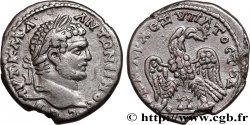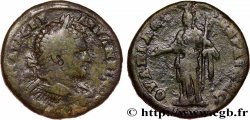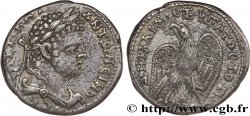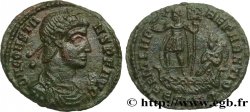E-auction 154-92384 - bpv_153687 - CARACALLA Tétradrachme syro-phénicien
You must signin and be an approved bidder to bid, LOGIN TO BID. Accounts are subject to approval and the approval process takes place within 48 hours. Do not wait until the day a sale closes to register. Clicking on « bid » constitutes acceptance of the terms of use of cgb.fr private e-auctions.
Bids must be placed in whole Euro amounts only. The sale will start closing at the time stated on the item description; any bids received at the site after the closing time will not be executed. Transmission times may vary and bids could be rejected if you wait until the last second. For further information ckeck the E-auctions F.A.Q.
NO BUYER'S FEE.
NO BUYER'S FEE.
| Estimate : | 120 € |
| Price : | 57 € |
| Maximum bid : | 71 € |
| End of the sale : | 28 March 2016 15:11:30 |
| bidders : | 8 bidders |
Type : Tétradrachme syro-phénicien
Date: 215-217
Mint name / Town : Antioche, Syrie, Séleucie et Piérie
Metal : billon
Diameter : 26,00 mm
Orientation dies : 11 h.
Weight : 13,49 g.
Coments on the condition:
Légère usure de circulation régulière, sensible sur les lauriers et le ventre de l’aigle, coin de droit assez mou, bon centrage, patine sombre, éclat de flan derrière la nuque
Catalogue references :
Predigree :
Cet exemplaire est le 0226_017 de la base TSP
Obverse
Obverse description : Buste lauré, cuirassé (ptéryge visible) et drapé de Caracalla à gauche, vu de trois-quarts arrière avec une barbe fournie, les deux rubans de la couronne de laurier flottant derrière la tête.
Obverse legend : ANTWNEINOS - SEB AUT K. M.
Obverse translation : (Antonin auguste empereur césar Marc Aurèle).
Reverse
Reverse description : Aigle à gauche, ailes écartées, tête et queue à droite, tenant un cuissot d’animal sacrificiel dans ses serres, souris à droite, et une couronne perlée de lauriers dans son bec.
Reverse legend : DHMARC .EX. UPATO. D., .D. .E.
Reverse translation : (Revêtu de la puissance tribunitienne consul pour la quatrième fois).
Commentary
La caractéristique spécifique à ce type, Prieur 226, est, outre la présence d’un Delta Eta dans le champ du revers, le buste drapé et cuirassé, tourné à gauche. On pourrait gloser sur la concordance, dans ce groupe, des bustes militaires et de l’orientation à gauche, mais cette concordance disparaissant dès les émissions de guerre proprement dites, ce serait probablement vain. Ces émissions à bustes militaires sont relativement peu nombreuses, de l’ordre du sixième des frappes du groupe. On remarquera la position curieuse de la légende, mais, là encore, probablement rien de signifiant puisque les positions redeviennent usuelles pour les émissions militaires de 215/217.
La qualité de gravure et de frappe est toujours bonne, voire très bonne, mais l’empereur commence à voir son portrait vieillir et les rides épaisses qui marquent son front, en sont une bonne illustration.
On peut raisonnablement penser que les graveurs ont voulu exprimer la personnalité autant que l’aspect réel - l’empereur n’a que 28 ans - en exagérant ces traits. On peut aussi penser que la vie de débauche dont son père avait essayé de l’extraire, par exemple en organisant une campagne un peu superflue en Bretagne, l’a profondément marqué. Notre exemplaire est peut-être du début de la série et ne présente pas encore franchement le pli dédaigneux de la lèvre qui deviendra fréquent dès les prochaines émissions.
On note que les sigma sont gravés en C et que Richard McAlee ne différencie par les légendes, regroupant donc en une seule référence, 682, les Prieur 226, 227 et 228.
Dans la base TSP maintenue par Michel Prieur, quarante exemplaires sont maintenant répertoriés dont en musées Paris (3), ANS, Yale et Boston (ex Gush Halav Hoard).
The specific characteristic of this type, Prieur 226, is, besides the presence of a Delta Eta in the field of the reverse, the draped and armored bust, turned to the left. One could discuss the concordance, in this group, of military busts and left-wing orientation, but since this concordance disappears from the war broadcasts themselves, it would probably be in vain.. These military bust emissions are relatively few in number, around one sixth of the group's strikes.. We will note the curious position of the legend, but, again, probably nothing significant since the positions become usual again for the military broadcasts of 215/217.
The quality of the engraving and striking is still good, even very good, but the emperor is beginning to see his portrait age and the thick wrinkles that mark his forehead are a good illustration of this..
It is reasonable to assume that the engravers wanted to express the personality as much as the real appearance - the emperor was only 28 years old - by exaggerating these features.. We can also think that the life of debauchery from which his father had tried to extract him, for example by organizing a somewhat superfluous campaign in Brittany, had a profound effect on him.. Our copy is perhaps from the beginning of the series and does not yet clearly show the disdainful crease of the lip which will become frequent from the next issues..
We note that the sigmas are engraved in C and that Richard McAlee does not differentiate the legends, thus grouping in a single reference, 682, the Prieur 226, 227 and 228.
In the TSP database maintained by Michel Prieur, forty copies are now listed, including those in museums in Paris (3), ANS, Yale and Boston (ex Gush Halav Hoard)
La qualité de gravure et de frappe est toujours bonne, voire très bonne, mais l’empereur commence à voir son portrait vieillir et les rides épaisses qui marquent son front, en sont une bonne illustration.
On peut raisonnablement penser que les graveurs ont voulu exprimer la personnalité autant que l’aspect réel - l’empereur n’a que 28 ans - en exagérant ces traits. On peut aussi penser que la vie de débauche dont son père avait essayé de l’extraire, par exemple en organisant une campagne un peu superflue en Bretagne, l’a profondément marqué. Notre exemplaire est peut-être du début de la série et ne présente pas encore franchement le pli dédaigneux de la lèvre qui deviendra fréquent dès les prochaines émissions.
On note que les sigma sont gravés en C et que Richard McAlee ne différencie par les légendes, regroupant donc en une seule référence, 682, les Prieur 226, 227 et 228.
Dans la base TSP maintenue par Michel Prieur, quarante exemplaires sont maintenant répertoriés dont en musées Paris (3), ANS, Yale et Boston (ex Gush Halav Hoard).
The specific characteristic of this type, Prieur 226, is, besides the presence of a Delta Eta in the field of the reverse, the draped and armored bust, turned to the left. One could discuss the concordance, in this group, of military busts and left-wing orientation, but since this concordance disappears from the war broadcasts themselves, it would probably be in vain.. These military bust emissions are relatively few in number, around one sixth of the group's strikes.. We will note the curious position of the legend, but, again, probably nothing significant since the positions become usual again for the military broadcasts of 215/217.
The quality of the engraving and striking is still good, even very good, but the emperor is beginning to see his portrait age and the thick wrinkles that mark his forehead are a good illustration of this..
It is reasonable to assume that the engravers wanted to express the personality as much as the real appearance - the emperor was only 28 years old - by exaggerating these features.. We can also think that the life of debauchery from which his father had tried to extract him, for example by organizing a somewhat superfluous campaign in Brittany, had a profound effect on him.. Our copy is perhaps from the beginning of the series and does not yet clearly show the disdainful crease of the lip which will become frequent from the next issues..
We note that the sigmas are engraved in C and that Richard McAlee does not differentiate the legends, thus grouping in a single reference, 682, the Prieur 226, 227 and 228.
In the TSP database maintained by Michel Prieur, forty copies are now listed, including those in museums in Paris (3), ANS, Yale and Boston (ex Gush Halav Hoard)







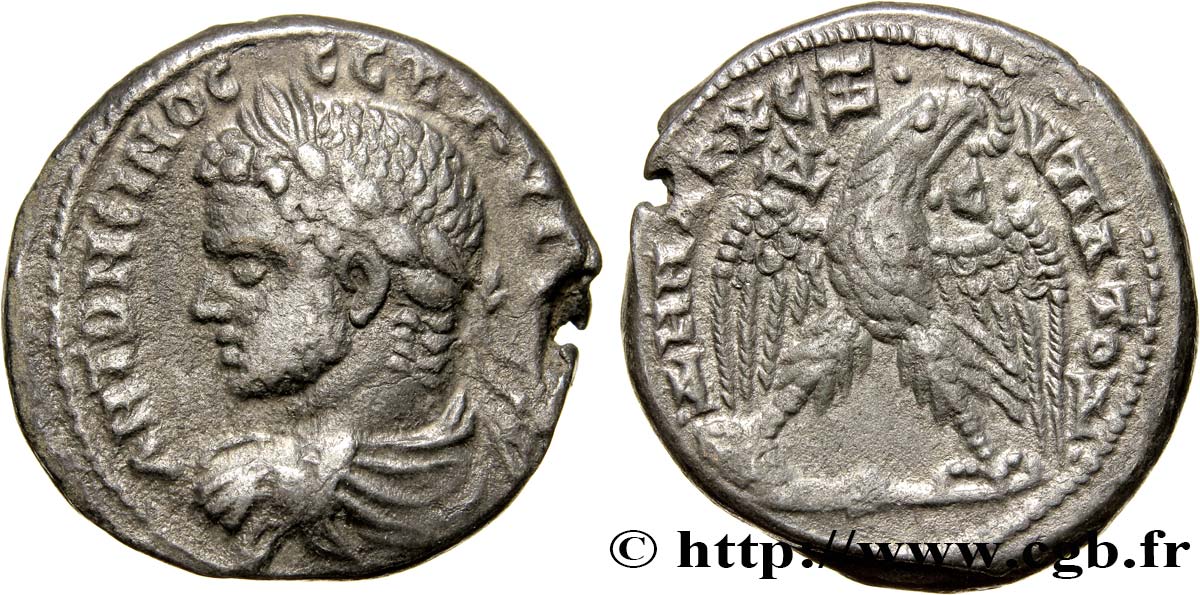
 Report a mistake
Report a mistake Print the page
Print the page Share my selection
Share my selection Ask a question
Ask a question Consign / sell
Consign / sell
 Full data
Full data